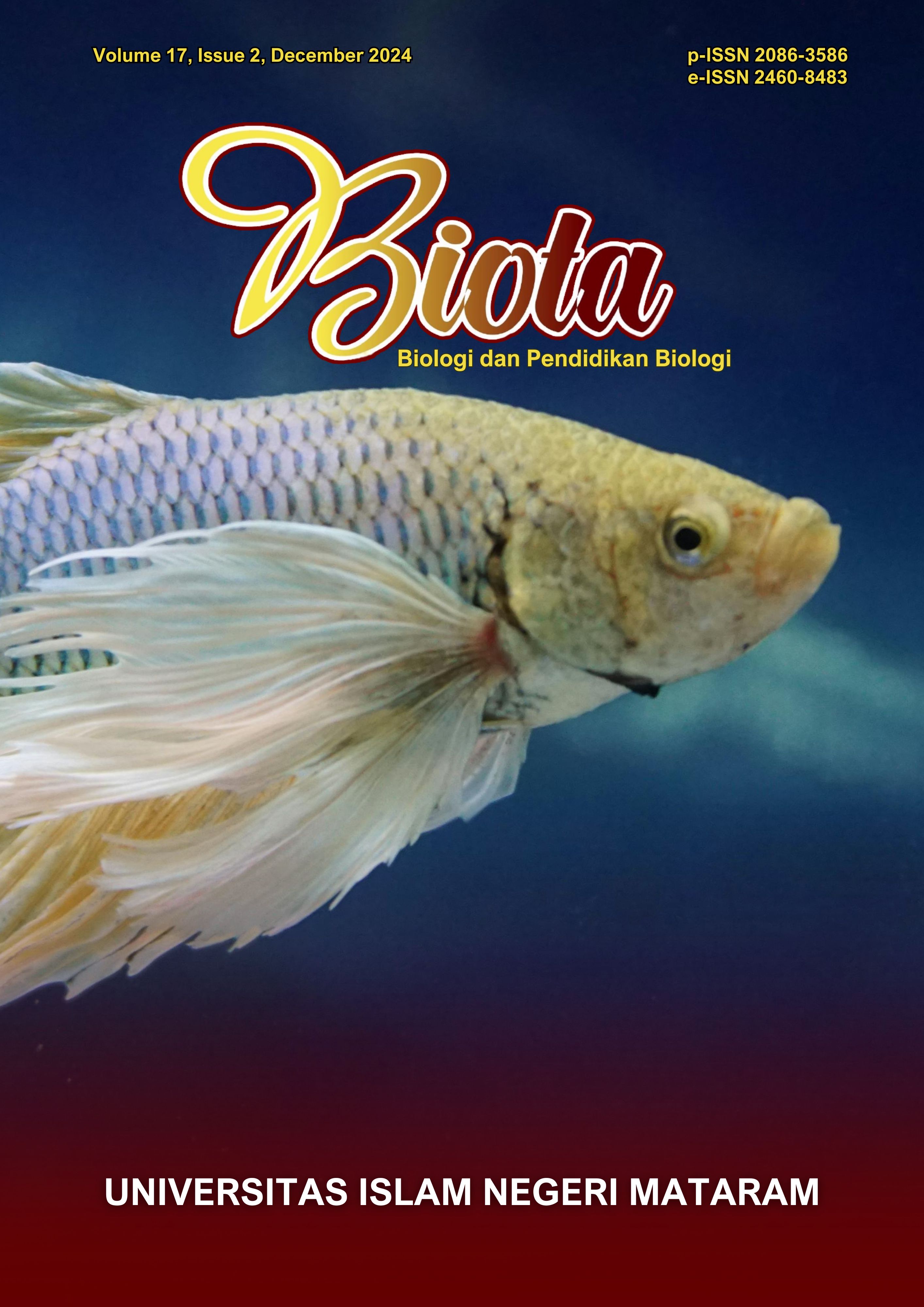Phenology of Flowing and Fruiting in Rukam Growth (Flacourtia rukam Zoll. & Moritzi)
Main Article Content
Abstract
Rukam is one of the fruiting plants that grow wild in the forest or are planted. Excessive utilization without cultivation efforts triggers a decrease in the population of a species in nature until a species disappears from nature. Flacourtia rukam has most recently been assessed for The IUCN Red List of Threatened Species in 2023. Flacourtia rukam is listed as Least Concern. Therefore, knowledge of flower and fruit development is needed to determine the effectiveness of production on rukam plants through phenological studies. This study was conducted to obtain information through morphological changes that occur and the length of time required during the flowering process to fruit formation on rukam. This research was conducted by directly observing and measuring the parts of the inflorescence from the process of fruit formation until the fruit ripenning. The results showed that the morphological structure of rukam flowers is incomplete. The phenology of rukam flowering and fruiting takes 56 - 61 days starting with the flower initiation phase and ending with the mature fruit phase. The stages of morphological changes in flower development can be divided into initiation, small flower buds, large flower buds, and blooming flowers (anthesis). While the stages of morphological changes in fruit, color and size can be divided into young fruit, mature fruit, ripe fruit, and deciduous fruit. All stages of color change occur during the fruit ripening process
Article Details

This work is licensed under a Creative Commons Attribution-ShareAlike 4.0 International License.
References
Agusta, W., & Ahmad, U. 2016. Mempelajari Tingkat Kematangan Buah Melon Golden Apollo Menggunakan Parameter Sinyal Suara. Jurnal Keteknikan Pertanian, 4(2), 195-202.
Barlian, J. H. Yeni, Masano. 1998. Study of Phenology and Fruit Position Effect and Seed Size on Gmelina Seed Viability. Bulletin Agronomy, 26(2), 8–12.
Dafni, A. 1993. Pollination Biology: a Practical Approach. Oxford: University Press.
Darjanto, & Satifah, S. 1990. Pengetahuan Dasar Biologi Bunga dan Teknik Penyerbukan Silang Buatan. Jakarta: PT Gramedia.
Deshmukh, B. S., Waghmode, A., & Arts, A. 2011. Role of wild edible fruits as a food resource: Traditional knowledge. International Journal of Pharmacy & Life Sciences, 2(7), 919–924.
Desitarani, Wiriadinata, H., Miyakawa, H., Rachman, I., Rugayah, Sulistyono, & Partomihardjo, T. 2014. Buku Panduan Lapangan Jenis-jenis Tumbuhan Restorasi. Jakarta: LIPI.
Fitri, N., Ulandari, S. A., Waldani, O. I., Noviyani, S., & Allwar. 2016. Uji Aktivitas Antioksidan Ekstrak Daun Rukem (Flacourtia rukam) Dengan Metode DPPH (1,1-Difenil-2-Pkrilhidrazil), HKI: Prosiding Seminar Nasional Kimia-Lombok.
Giovannoni, J. 2001. Molecular Biology of Fruit Maturation and Ripening. Annu. Rev. Plant Physiol, (52), 725-749.
Hesthiati, E., Priatmodjo, D., Wisnubudi, G., & Sukartono, I. G. S. 2019. Keanekaragaman Hayati Tanaman Buah Langka Indonesia. Jakarta: Lembaga Penerbit Unas.
Kusumo, S. M., Hasanah, S., Moeljopawiro, M., Thohari, Subandriyo, A., Hardjamulia, A., Nurhadi, & Kasim, H. 2002. Pedoman Pembentukan Komisi Daerah dan Pengelolaan Plasma Nutfah. Badan Penelitian dan Pengembangan Pertanian. Bogor: Komisi Nasional Plasma Nutfah.
Lim, T. K. 2013. Edible Medicinal and non Medicinal Plants: Flacourtia rukam. Springer, The Netherland.
Nurtjahya, E., Inonu, I., Kartika, & Franto. 2012. Rona Lingkungan Kawasan Calon Tapak PLTN Bangka Selatan 2012. Pangkalpinang: UBB Press.
Pulatov, B., Linderson, M. L., Hall, K., Jonsson, A. M. 2015. Modeling climate change impact on potato crop phenology and the risk of frost damage in northern Europe. Agric For Meteorol, 214, pp.281-292.
Rana, Ghina, S. E., Lestario, L. N., & Martono, Y. 2018. Effect of Various Concentration Sugar Addition on the Color Stability of Rukem Fruit Anthocyanin Extract (Flacourtia rukam Zoll. & Mor.). Jurnal Aplikasi Teknologi Pangan, 7(4), 173–179.
Rugayah, Kusumadewi, S., Yulita, Arifiani, D., Rustiami, H., & Girmansyah, D. 2017. Tumbuhan Langka Indonesia: 50 Jenis Tumbuhan Terancam Punah. Jakarta: LIPI Press.
Sedgley, M., & Griffin, A. R. 1989. Sexual Reproduction of Tree Crops. San Diego: Academic Press Inc.
Sitompul, S. M., & Guritno, B. 1995. Analisis Pertumbuhan Tanaman. Yogyakarta: UGM Press.
Solikin & Budiharta. 2010. Potensi dan Konservasi Buah-Buahan Lokal Jawa Timur. Jawa Timur: Lembaga Ilmu Pengetahuan Indonesia.
Supriadi, & Janah, M. 2016. Aplikasi Ekstrak Daun Rukam (Flacourtia Sp) sebagai Anti Telaziasis pada Ternak Sapi Di Kabupaten Sumbawa. Lumbung Inovasi: Jurnal Pengabdian Kepada Masyarakat, 1(1), 41-50.
Thomas, B. 1993. Internal and External Control of Flowering. In: Jordan BR (Ed) Molecular Biology of Flowering. Sussex: CAB International.
Verheij, E. W. M., & Coronel, R. E. 1991. Plant Resources of South-East Asia No. 2: Edible Fruits and Nuts. Bogor: Prosea Foundation.

